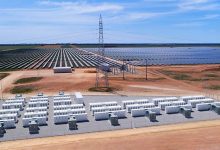The arrival of Australia’s first big battery – delivered by Tesla and Neoen at the Hornsdale Power Reserve in South Australia – generated a huge amount of publicity, then and still now, largely because it was the world’s biggest, and for its transformational impact on Australia’s main grid.
But it hides a growing phenomenon that begun before that famous installation, and continues apace: the growth of battery storage paired with large scale wind and solar projects in the world’s biggest electricity market, the US.
According to the latest data released by the US government’s Energy Information Administration (EIA), the pairing of renewable energy generators with energy storage, particularly batteries, is increasingly common as the cost of energy storage continues to decrease.
 Its latest inventory shows that the number of solar and wind generation sites co-located with batteries has grown from 19 paired sites in 2016 to 53 paired sites in 2019. And the EIA says this trend is expected to continue, with another 56 facilities pairing renewable energy and battery storage to come online by the end of 2023.
Its latest inventory shows that the number of solar and wind generation sites co-located with batteries has grown from 19 paired sites in 2016 to 53 paired sites in 2019. And the EIA says this trend is expected to continue, with another 56 facilities pairing renewable energy and battery storage to come online by the end of 2023.
This is not surprising. Battery storage costs have fallen to a point so low that they are pushing peaking gas generators out of the market – and in a market where the price of gas is supposedly cheap.
This part of the market, featuring two to four hour storage, is yet to feature prominently in Australia but is being discussed. And Australian investors, such as Quinbrook, are making major plays in the US battery storage market, as Sophie Vorrath reports here.
 This graph above shows that the main play for big batteries in the US is storing excess wind and solar (in contrast to Australia where it has been mostly frequency regulation – that is probably a result of the respective market structures and signals),
This graph above shows that the main play for big batteries in the US is storing excess wind and solar (in contrast to Australia where it has been mostly frequency regulation – that is probably a result of the respective market structures and signals),
Still, frequency control is the second most common use for big batteries in the US, along with back-up power, renewables “firming”, and then load management, ramping, arbitrage, load following and reactive power support.
“Although the most commonly reported application for batteries co-located with renewable sources is storing excess energy, the majority of batteries serve more than one function,” the report notes.
“Frequency regulation, which helps maintain the grid’s electric frequency on a second-to-second basis, is the second-most common use for batteries co-located with renewables.
“Batteries can also provide transmission and distribution support, helping to smooth out energy flows. The ability to support the integration of renewables into the grid’s current infrastructure, in addition to other ancillary services that they perform such as frequency regulation, are primary drivers in the growth of battery-renewable pairings.”
 The EIA notes that 90 per cent of these so-called hybrid (wind and/or solar paired with batteries) is located in just nine states, with Texas leading the way, followed by Nevada and California.
The EIA notes that 90 per cent of these so-called hybrid (wind and/or solar paired with batteries) is located in just nine states, with Texas leading the way, followed by Nevada and California.
Reported data show that future projects will be much larger in scale than currently operating projects. One anticipated projected in Nevada called Gemini Solar – backed by Quinbrook – is expected to add more than one gigawatt of combined renewable and storage capacity.
RenewEconomy and its sister sites One Step Off The Grid and The Driven will continue to publish throughout the Covid-19 crisis, posting good news about technology and project development, and holding government, regulators and business to account. But as the conference market evaporates, and some advertisers pull in their budgets, readers can help by making a voluntary donation here to help ensure we can continue to offer the service free of charge and to as wide an audience as possible. Thank you for your support.










